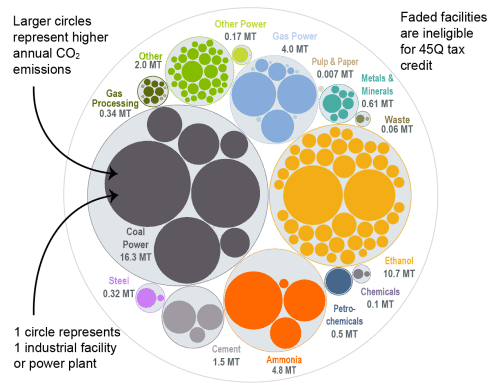Iowa Carbon Capture Opportunities

Carbon management technologies can lower emissions across a variety of sectors in Iowa and bring jobs and private investment to the state. Of the 151 industrial and power facilities in the state, 113 are eligible for the 45Q federal tax credit. The highest proportion of these facilities are 40 ethanol plants, which emit around 11 million metric tons of carbon dioxide (CO2) annually. In total, all 113 45Q-eligible facilities emit around 41 million metric tons of CO2 annually, representing 99 percent of total annual CO2 emissions in Iowa.
Iowa’s legislature has introduced many pieces of legislation in recent sessions to address the regulation of carbon management. While Governor Kim Reynolds has signaled support for carbon management technologies through the creation of a Carbon Sequestration Task Force in 2021, the state could benefit from enacting additional supportive policies to further accelerate deployment and establish a robust regulatory framework.

Industrial and Power Facilities in Iowa
Iowa has 113 facilities that are eligible for the 45Q tax credit. Iowa’s ethanol sector, a key economic driver in the state, represents the highest proportion of facilities and is the state’s second-highest emitter, right behind Iowa’s coal power industry. In addition to 40 ethanol facilities and seven coal power plants, Iowa has six gas power plants, four ammonia plants, three cement facilities, and 53 additional 45-eligible facilities. In total, these 113 facilities emit approximately 41 million metric tons of CO2 annually, representing 99 percent of the state’s annual CO2 emissions.
While Iowa may have limited storage potential in traditional saline geologic formations, the Iowa Geological Survey is exploring storage potential in basalt formations present in the state’s subsurface. Additionally, Iowa is well-positioned as a corridor for transporting CO2 regionally.

Source: EPA GHGRP, 2024.
Legislative Context for Carbon Management
At the recommendation of the Governor’s Economic Recovery Advisory Board, Governor Kim Reynolds signed an Executive Order in 2021 creating a Carbon Sequestration Task Force. The task force was mandated to study the economic opportunities for carbon storage strategies across several industries, including agriculture, natural resources, energy, and transportation. The task force’s goals are to review the current state of research, advise on how best to capitalize on the economic opportunities, and identify the role of state government in carbon markets.
More recently, the Iowa legislature introduced several pieces of legislation related to carbon management in the 2023 and 2024 legislative sessions. In 2025, several consequential bills were introduced but failed to pass:
- HF 780: Prohibits the Iowa Utilities Commission from renewing permits for CO2 pipelines, effectively capping their operational lifespan at a maximum of 25 years.
- SF 249: Allows anyone within 25 miles of a CO2 release from a pipeline or facility—whether residing, traveling, visiting, or owning property, equipment, or livestock—to take legal action against the facility or pipeline owner within one year of the incident. It imposes strict liability on the owner for all compensatory and punitive damages.
- SF 136: Mandates several safety requirements for CO2 pipeline operators and regulators.
One bill, HF 639, did pass, but was vetoed in June 2025 by Iowa Governor Kim Reynolds. This bill would have placed new restrictions on the use of eminent domain for carbon pipelines and similar infrastructure projects.
To see real time updates on active state legislation, view our State Legislative Tracker.
This bubble diagram shows the number of facilities and corresponding annual CO2 emissions for each industry in Iowa. The darker bubbles are eligible for the 45Q carbon capture tax credit, while the faded bubbles are too small to be eligible. The total amount of CO2 emissions in Iowa is listed for each industry in million metric tons.

Source: EPA GHGRP, 2024.
Last updated: May 2025

